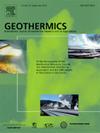Study on the spatial characteristics and controlling factors of subsurface temperature field in concealed Salt Lake geothermal reservoir, Yuncheng city, Shanxi Province, China
IF 3.5
2区 工程技术
Q3 ENERGY & FUELS
引用次数: 0
Abstract
The middle- and low-temperature sandstone-type Salt Lake geothermal field in the Yuncheng region, located in the southern part of the Shanxi Rift, is situated beneath densely populated urban areas, which poses significant challenges for the exploration and development of geothermal fields. This study first revealed the subsurface temperature characteristics from temperature logs, further employed microtremor survey to explore the underlying structures controlling this temperature distribution and finally elucidate the underlying mechanism with numerical simulation. The results obtained from ordinary kriging-based interpolation of available borehole temperature logs show that the geothermal gradient and temperature maps at different depths all have the characteristics of high values in the southwestern part and low in the northeastern part. This pattern was interpreted to be separated by an NW-trending belt. The applied 2D microtremor survey identified a vertical low-velocity anomaly which is inferred to be a highly fractured zone. The numerical simulation, incorporating coupled heat transport and fluid flow processes, indicates that this highly fractured zone may facilitate the movement of cold surface lake water into deeper regions. During this process, the water absorbs heat, which effectively accounts for the low thermal anomalies observed in the eastern sections of Salt Lake geothermal reservoir. By integrating thermal investigation, microtremor survey and numerical simulation, this study successfully delineated temperature maps at different depths, but also explained the mechanism of geothermal anomalies. These findings offer valuable insights and a solid basis for exploring deep geothermal resources within Salt Lake district of Yuncheng city.

山西运城隐伏盐湖地热储层地下温度场空间特征及控制因素研究
运城地区中低温砂岩型盐湖地热田位于山西裂谷南段,地处人口密集的城区之下,为地热田勘探开发带来了重大挑战。本研究首先通过温度测井揭示了地下温度特征,然后利用微震测量探索控制温度分布的下伏构造,最后通过数值模拟阐明下伏机理。利用普通克里格插值法对现有井温测井资料进行插值,结果表明,不同深度的地温梯度和地温图均具有西南高、东北低的特征。这一模式被解释为被一条北西走向的带所分隔。应用二维微震测量确定了一个垂直低速异常,推断这是一个高度断裂带。结合热输运和流体流动耦合过程的数值模拟表明,这一高度断裂带可能有利于表层湖泊冷水向深层移动。在此过程中,水吸收热量,有效地解释了盐湖地热储层东段低热异常的原因。通过热调查、微震调查和数值模拟相结合,成功圈定了不同深度的温度分布图,并解释了地热异常的成因机制。这些发现为运城市盐湖地区深部地热资源的勘探提供了有价值的见解和坚实的基础。
本文章由计算机程序翻译,如有差异,请以英文原文为准。
求助全文
约1分钟内获得全文
求助全文
来源期刊

Geothermics
工程技术-地球科学综合
CiteScore
7.70
自引率
15.40%
发文量
237
审稿时长
4.5 months
期刊介绍:
Geothermics is an international journal devoted to the research and development of geothermal energy. The International Board of Editors of Geothermics, which comprises specialists in the various aspects of geothermal resources, exploration and development, guarantees the balanced, comprehensive view of scientific and technological developments in this promising energy field.
It promulgates the state of the art and science of geothermal energy, its exploration and exploitation through a regular exchange of information from all parts of the world. The journal publishes articles dealing with the theory, exploration techniques and all aspects of the utilization of geothermal resources. Geothermics serves as the scientific house, or exchange medium, through which the growing community of geothermal specialists can provide and receive information.
 求助内容:
求助内容: 应助结果提醒方式:
应助结果提醒方式:


